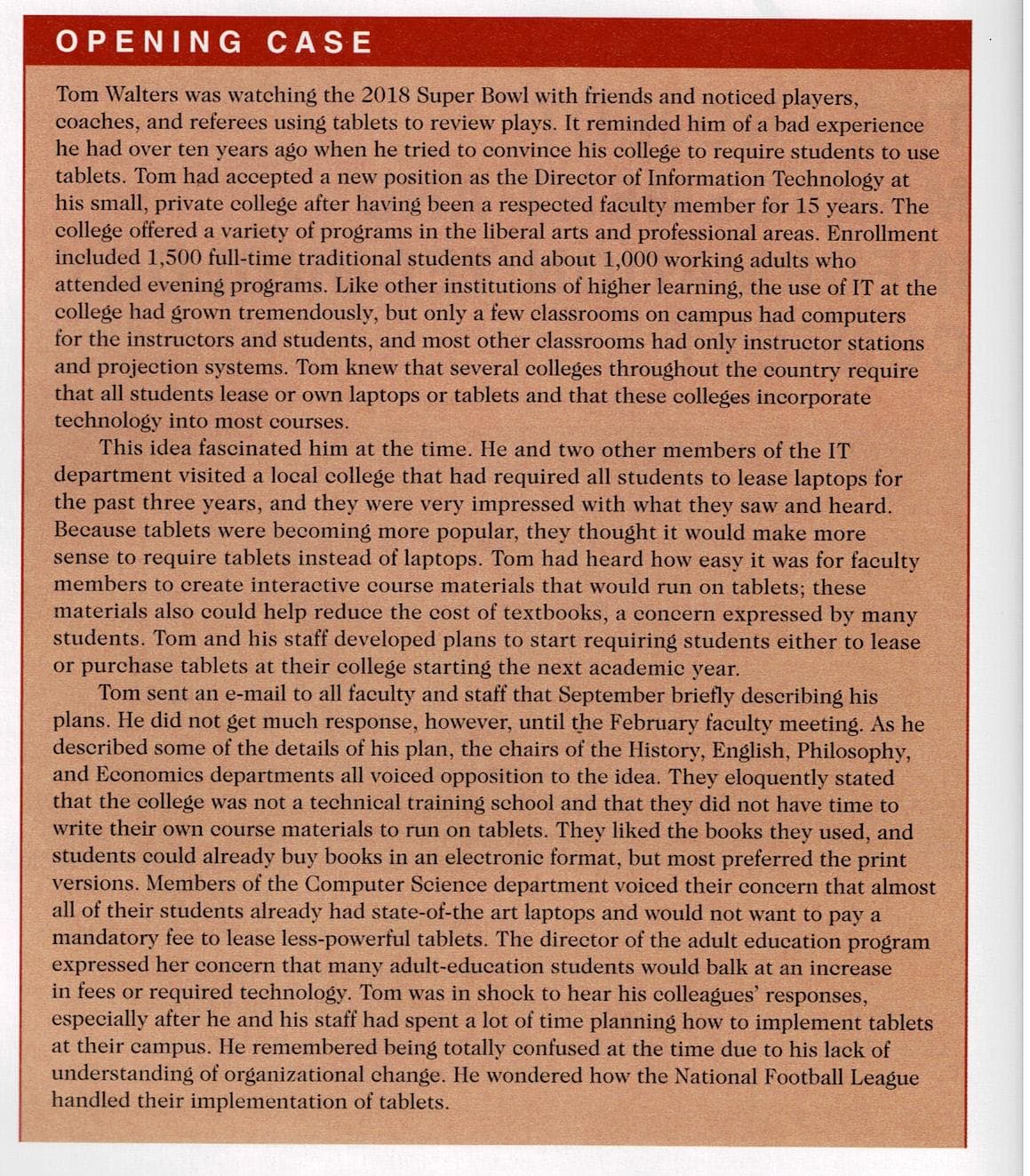What could be the alternative solutions to the problems?
Chapter1: Taking Risks And Making Profits Within The Dynamic Business Environment
Section: Chapter Questions
Problem 1CE
Related questions
Question
What could be the alternative solutions to the problems?

Transcribed Image Text:OPENING CASE
Tom Walters was watching the 2018 Super Bowl with friends and noticed players,
coaches, and referees using tablets to review plays. It reminded him of a bad experience
he had over ten years ago when he tried to convince his college to require students to use
tablets. Tom had accepted a new position as the Director of Information Technology at
his small, private college after having been a respected faculty member for 15 years. The
college offered a variety of programs in the liberal arts and professional areas. Enrollment
included 1,500 full-time traditional students and about 1,000 working adults who
attended evening programs. Like other institutions of higher learning, the use of IT at the
college had grown tremendously, but only a few classrooms on campus had computers
for the instructors and students, and most other classrooms had only instructor stations
and projection systems. Tom knew that several colleges throughout the country require
that all students lease or own laptops or tablets and that these colleges incorporate
technology into most courses.
This idea fascinated him at the time. He and two other members of the IT
department visited a local college that had required all students to lease laptops for
the past three years, and they were very impressed with what they saw and heard.
Because tablets were becoming more popular, they thought it would make more
sense to require tablets instead of laptops. Tom had heard how easy it was for faculty
members to create interactive course materials that would run on tablets; these
materials also could help reduce the cost of textbooks, a concern expressed by many
students. Tom and his staff developed plans to start requiring students either to lease
or purchase tablets at their college starting the next academic year.
Tom sent an e-mail to all faculty and staff that September briefly describing his
plans. He did not get much response, however, until the February faculty meeting. As he
described some of the details of his plan, the chairs of the History, English, Philosophy,
and Economics departments all voiced opposition to the idea. They eloquently stated
that the college was not a technical training school and that they did not have time to
write their own course materials to run on tablets. They liked the books they used, and
students could already buy books in an electronic format, but most preferred the print
versions. Members of the Computer Science department voiced their concern that almost
all of their students already had state-of-the art laptops and would not want to pay a
mandatory fee to lease less-powerful tablets. The director of the adult education program
expressed her concern that many adult-education students would balk at an increase
in fees or required technology. Tom was in shock to hear his colleagues' responses,
especially after he and his staff had spent a lot of time planning how to implement tablets
at their campus. He remembered being totally confused at the time due to his lack of
understanding of organizational change. He wondered how the National Football League
handled their implementation of tablets.
Expert Solution
This question has been solved!
Explore an expertly crafted, step-by-step solution for a thorough understanding of key concepts.
Step by step
Solved in 2 steps

Recommended textbooks for you

Understanding Business
Management
ISBN:
9781259929434
Author:
William Nickels
Publisher:
McGraw-Hill Education

Management (14th Edition)
Management
ISBN:
9780134527604
Author:
Stephen P. Robbins, Mary A. Coulter
Publisher:
PEARSON

Spreadsheet Modeling & Decision Analysis: A Pract…
Management
ISBN:
9781305947412
Author:
Cliff Ragsdale
Publisher:
Cengage Learning

Understanding Business
Management
ISBN:
9781259929434
Author:
William Nickels
Publisher:
McGraw-Hill Education

Management (14th Edition)
Management
ISBN:
9780134527604
Author:
Stephen P. Robbins, Mary A. Coulter
Publisher:
PEARSON

Spreadsheet Modeling & Decision Analysis: A Pract…
Management
ISBN:
9781305947412
Author:
Cliff Ragsdale
Publisher:
Cengage Learning

Management Information Systems: Managing The Digi…
Management
ISBN:
9780135191798
Author:
Kenneth C. Laudon, Jane P. Laudon
Publisher:
PEARSON

Business Essentials (12th Edition) (What's New in…
Management
ISBN:
9780134728391
Author:
Ronald J. Ebert, Ricky W. Griffin
Publisher:
PEARSON

Fundamentals of Management (10th Edition)
Management
ISBN:
9780134237473
Author:
Stephen P. Robbins, Mary A. Coulter, David A. De Cenzo
Publisher:
PEARSON